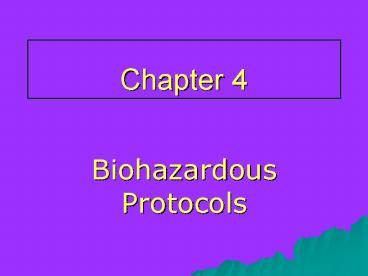Biohazardous Protocols - PowerPoint PPT Presentation
1 / 24
Title:
Biohazardous Protocols
Description:
Lacerations. Punctures. Wounds. Abrasion. Outer layer of skin is damaged. ... Laceration Cont... Example: Being struck with a projectile (rock). Colliding heads. ... – PowerPoint PPT presentation
Number of Views:523
Avg rating:3.0/5.0
Title: Biohazardous Protocols
1
Chapter 4
- Biohazardous Protocols
2
Classification and Management of Wounds
- Wounds involve a compromise to the integumentary
(skin) system. - Classifications
- Abrasions
- Avulsions
- Incisions
- Lacerations
- Punctures
3
Wounds
4
Abrasion
- Outer layer of skin is damaged.
- Superficial wound.
- Bleeding is limited (capillaries damage).
- Very painful due to nerve endings being damaged.
- Particles could be embedded in skin which
increases infection risk.
5
Abrasion
6
Abrasion Treatment
- Use latex gloves.
- Clean area with soap and water.
- Gentle scrub dirt away from wound.
- Apply Neosporin ointment to a bandage and gentle
apply bandage over wound.
7
Abrasion Follow-up Care
- Change dressing daily.
- Allow to air out at night.
- Keep wound clean.
8
Avulsion
- A forcible separation or tearing of tissue from
the body (skin flap). - Heavy and rapid bleeding.
9
Avulsion
10
Avulsion Care
- Use latex gloves!
- Clean around the wound being careful to not wipe
anything into wound. - Apply sterile gauze pad over wound.
- Wrap avulsed body part in sterile gauze.
- Place body part in a cold container.
- Take victim to hospital tetanus is possible.
11
Incision
- A sharp-cut wound caused by a sharp object like
glass or metal. - Deep cuts will cause rapid and heavy bleeding.
- May damage muscles, tendons, ligaments, and/or
nerves.
12
Incision treatment
- Use latex gloves.
- Clean with disinfectant (superficial wounds).
- Apply Neosporin to a sterile gauze bandage and
gently cover wound. - See a physician tetanus is possible.
13
Incision Follow-up care
- Change dressing daily.
- Keep wound clean.
- Watch for infections.
14
Laceration
- An irregular tear in the soft tissue (skin).
15
(No Transcript)
16
Laceration Cont
- Example
- Being struck with a projectile (rock).
- Colliding heads.
- Being kicked.
- Initial and Follow Care
- Same as Incisions.
17
Puncture
- A small hole in the tissue produced by an object
piercing the skin layers. - External bleeding is limited.
- Internal damage/bleeding may be extensive.
18
Puncture Care
- Initial
- Use latex gloves.
- Clean around the wound.
- DO NOT remove anything from the wound.
- Bandage punctured item in place.
- Refer to physician.
- Tetanus shot.
19
Puncture cont
- Follow up
- Change dressings regularly.
- Watch for infection. Infections more likely
because puncture wounds lack the external
bleeding that flushes a wound.
20
Biohazard - Gloves
- -Always use latex gloves when treating an athlete
with exposed body fluids. - -Provide a barrier between trainer and the
wound/body fluid. - -Should be worn at all times when evaluating an
athletepossible undiscovered, open wound.
21
Gloves cont
- -Protects against body fluids
- -blood from a wound.
- -serum/pus fluid from a blister.
- -vomit from an ill athlete.
- -saliva
- -urine/fecal matter.
22
Gloves cont
- Latex gloves general guidelines
- -Protective value diminishes after 10-15 minutes.
- -If gloves tear, replace them immediately.
- -Wear the proper size glove.
- -After use Gloves and contaminated materials
should be disposed of properly in a biohazard
infectious waste container.
23
Biohazard cont
- -Athletic Trainer should properly clean the
contaminated athletic training room/location. - -Bleach water solution1/10 bleach/water.
- -A bleach/water solution keeps its effectiveness
for about 24 hours (1day). - -The bloodborne pathogens of most concern are
- HIV
- Hepatitis B
24
- In 1994 the National Federation of State High
School Associations adopted its 9 point
Communicable Disease Procedures - 1. Stop bleeding and remove blood from uniforms.
- 2. Use precautions when handling body fluids.
- 3. Wash body surfaces exposed to body fluids.
- 4. Clean all surfaces and equipment before
resuming play. - 5. Properly dispose of sharps and body fluids.
- 6. Use artificial ventilation devices when
performing CPR. - 7. Support personnel must follow precautions if
their skin is broken. - 8. Proper cleaning and/or disposal of blood
soaked towels. - 9. Follow accepted guidelines for controlling
bleeding.































